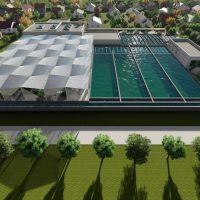How Do I Construct an Organica-Powered Facility?
- Is it more expensive to build than a traditional treatment plant?
No – Organica WWTPs are actually constructed at very similar total costs to conventional systems, particularly when considering capacities of 5000 m3/d and above. - How long does it take to build an Organica facility?
Facilities are typically built within six to nine months, depending upon the project size. The construction phase is followed by a testing and commissioning period (approximately 3 to 6 months). During this time the system stabilizes and can be optimized as needed. - What are the cordon sanitaire requirements?
Buffer zone requirements depends on the local regulations, however thanks to the odor-free and noiseless operation, in addition to the aesthetically appealing image of FCR designs, regulators often break down the cordon sanitaire to 50 meters or less. - Are Organica facilities smaller than alternative processes?
The combination of smaller reactor volumes, lower suspended solids, and creative architectural design results in land requirements up to 60% less than activated sludge designs for the same application. The smaller space requirement results in less land usage and reduced construction costs compared to alternative approaches. - What happens until the plants mature?
Typical commissioning time of an Organica WWTP is around 3 months. During this period, sufficient surface area is available on the root structures (both natural and engineered) for sufficient biofilm growth to allow complete treatment, even if the plant root structure (under water) has not fully developed. - Is the greenhouse or shading structure difficult to build?
Both greenhouses (necessary in colder climates) and shading structures (suitable for warmer climates) are relatively inexpensive to build, and are already manufactured on a large scale for the agricultural industry. We commonly recommend greenhouses available “off the shelf” with all inbuilt functionalities for climate control (such as wind meter, thermometer, etc.).

